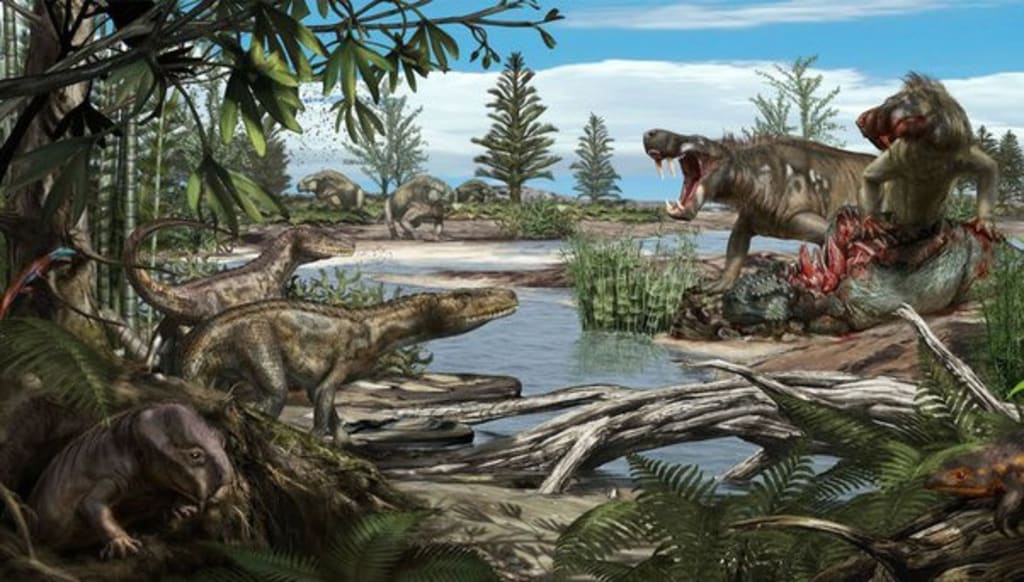The Era before Dinosaurs: A Look into the Life on Earth Prior to their Existence
Exploring the Paleozoic and Mesozoic Eras and the Diverse Range of Ancient Creatures that Ruled the Land, Sea, and Sky

The Paleozoic and Mesozoic Eras were milestones in the history of our planet. These eras marked the time before and during the age of dinosaurs, and they were home to a diverse range of ancient creatures that ruled the land, sea, and sky. These prehistoric beasts ranged from small creatures that were only a few feet long to some of the biggest animals to have ever roamed the Earth.
During the Paleozoic Era, which spanned from 541 to 252 million years ago, there was an explosion of life on Earth. This era saw the rise of many new groups of plants, including ferns, horsetails, and club mosses. It was also during this time that the first seed-bearing plants called gynosperms appeared. The most common creatures on land were prehistoric amphibians, which evolved from fish that were sick of being in the water all the time, so they decided to take a stroll on dry land. However, these early amphibians depended on water to lay their eggs and stay hydrated, so they had to stay close to lakes, rivers, and oceans.
The first true reptile called hylanimous evolved at the end of the Paleozoic era. Hylanimous had scaly skin and four legs, which allowed them to move away from the water and explore dry land. The evolution of reptiles coincides with the rise of peat bogs during this time. These peat bogs acted as a carbon sink and produced more and more oxygen, creating an environment where complex animals like hylanimous could develop.
300 million years ago, Earth was hotter and drier, which was not that good for amphibians but a game-changer for small reptiles like hylanimous. These reptiles were able to regulate their body temperature and lay eggs on the land, so they didn't need to stay close to water. This is when they started evolving into different groups, one of which was called pelicosaurs. Pelicosaurs lived in different ways; some ate plants while others preferred meat. The most famous pelicosaur is probably dimetrodon, with a big sail on its back, which people often mistake for a dinosaur.
Over time, some pelicosaurs evolved into the so-called mammal-like reptiles called therapsids. Therapsids had stronger jaws and sharper teeth, and some could stand upright on their legs. One species of therapsid was gorgonopsian, which went after armored and related to Turtles animals. These animals had skulls about 1.6 feet long and sharp teeth in both the lower and upper jaw.
The Permian Extinction, about 250 million years ago, wiped out 90% of all species on Earth, including animals in the seas and on land, as well as most of the trees. Scientists are still not sure what caused this extinction, but hypotheses suggest a massive asteroid impact, toxic levels of carbon dioxide in the ocean, or massive volcanic eruptions. Despite all the challenges, the therapsids survived and evolved into many different groups. Some even had fur and gave birth to live young, which are characteristics of mammals rather than reptiles.
The Mesozoic Era, which began 252 million years ago and ended with the extinction of the dinosaurs 66 million years ago, is sometimes called the "Age of Reptiles." During this era, the Earth saw the rise of new reptilian groups, including crocodiles, turtles, and lizards, along with the famous dinosaurs. It was a time of enormous ecological diversity, with giant animals from both land and sea.
The Paleozoic and Mesozoic Eras were an exciting and challenging time in the history of our planet, giving rise to many fascinating and incredible creatures that ruled the Earth. Though some of these creatures have gone extinct, their fossils offer us a glimpse into their world and help us understand the evolution of life on Earth. From the first amphibians to the birth of dinosaurs, this era is full of wondrous and incredible discoveries that make us appreciate the vast diversity of life on our planet.
Prior to the reign of dinosaurs, Earth was inhabited by a diverse range of ancient creatures that ruled the land, sea, and sky. The Paleozoic Era, which began approximately 541 million years ago, was marked by the evolution of the first complex multicellular organisms. During this time, a variety of aquatic life forms, such as trilobites and brachiopods, dominated the oceans.
The Devonian Period, which occurred between 419 million and 359 million years ago, was known as the Age of Fish. This was a time of rapid diversification of aquatic life, as fish evolved a variety of forms, from armored fish to early sharks. Additionally, amphibians emerged from the waters and began to inhabit the land, adapting to survive in new environments.
The Carboniferous Period, which lasted from 359 million to 299 million years ago, was marked by the evolution of early reptiles. These creatures eventually led to the evolution of mammals, birds, and dinosaurs. The Permian Period, which occurred from 299 million to 251 million years ago, saw the emergence of the dominant reptiles known as synapsids, which gave rise to mammals.
Life during these periods was drastically different than what we know today, with species that are now extinct dominating the world. Though much of the landscape and creatures of these times may seem foreign to us, they laid the foundation for the evolution of life throughout history, including the rise of the dinosaurs that would eventually become the stars of the Mesozoic Era.






Comments
There are no comments for this story
Be the first to respond and start the conversation.